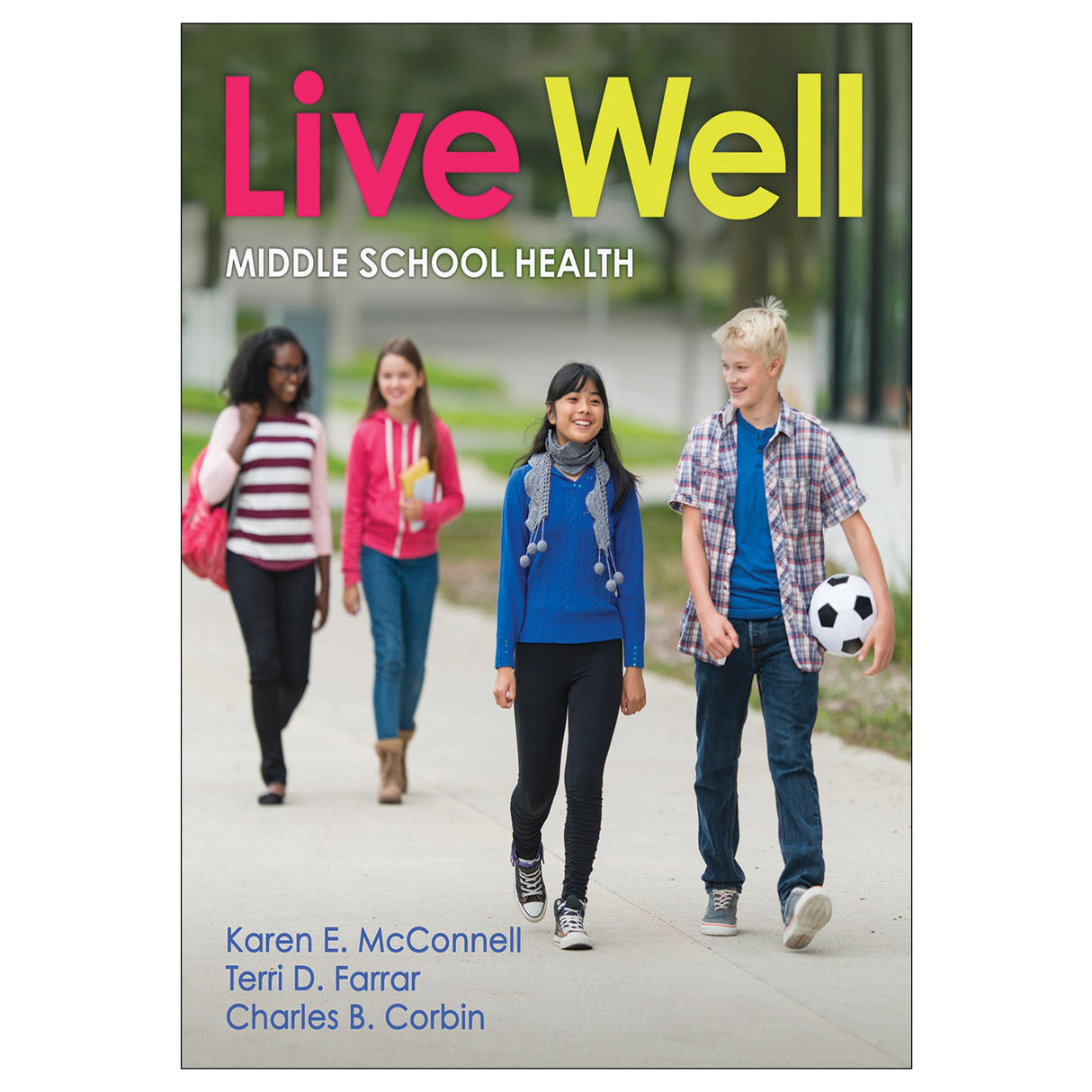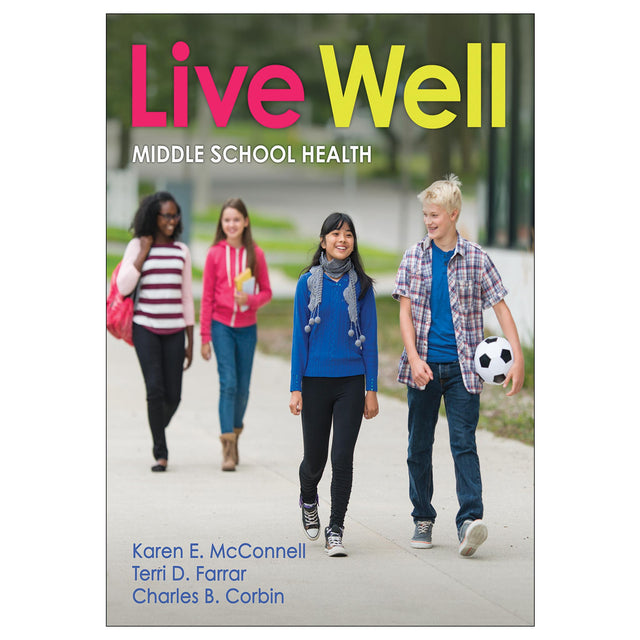Live Well Middle School Health With Web Resource
$142.95 CAD
The text will help students understand how to do the following:
- Develop skills for healthy living
- Prioritize healthy nutrition, physical activity, and stress management
- Avoid destructive habits
- Build healthy relationships
- Contribute to community and environmental health
Skills Developed
The content in Live Well: Middle School Health is aligned with the National Health Education Standards (NHES), state standards, and the CDC’s Health Education Curriculum Analysis Tool. The text will help students build an array of skills:
- Analyze the effect that family, peers, media, and technology have on their health and wellness
- Identify reliable sources of health information and become savvy consumers
- Sharpen interpersonal communication skills as they share health knowledge, debate controversial topics, manage interpersonal conflicts, and more
- Strengthen decision-making skills as they identify healthy solutions to problems posed
Features and Benefits
Live Well: Middle School Health offers students many features and benefits. The text provides skill-based learning applications to reinforce the health concepts and help students develop health literacy. Skill-building challenges, healthy living tips, career connections, and other recurring special elements supply opportunities to analyze, evaluate, and apply the health concepts and skills being taught. Case studies and other features allow students to engage with issues of diversity and inclusion across content areas. And vocabulary terms—available in English and Spanish to meet the needs of ELL and ESL students—help students test their understanding of the material.
To assist students using the print book or ebook, the Live Well: Middle School Health Web Resource features easy access to material referenced in the text, including note-taking guides, vocabulary terms with English and Spanish definitions and audio pronunciations, Skill-Building Challenge worksheets, and chapter reviews.
Live Well: Middle School Health is also available as an interactive web text, which students can access from a computer, tablet, or mobile device. The student interactive web textbook contains the same content as the print book but uses interactive audio, video, worksheets, and other great activities to help students engage with the material and enhance learning. The interactive web textbook offers audio vocabulary and definitions in English and Spanish. Introductory videos at the beginning of each lesson provide brief chapter overviews.
(The interactive web text is available separately to schools that adopt the student textbook. Please contact the Human Kinetics K-12 sales department for details.)
Note: A code for accessing the web resource is included with all new print books.
Audience
middle school health students and teachers, adopters, administrative decision makersChapter 1. Understanding Your Health
Lesson 1.1 Exploring Health and Wellness
Lesson 1.2 Developing Skills for Healthy Living
Lesson 1.3 Your Immune System
Lesson 1.4 Communicable Diseases
Lesson 1.5 Noncommunicable Diseases
Chapter 2. Personal and Consumer Health
Lesson 2.1 Healthy Skin, Hair, and Nails
Lesson 2.2 Good Oral Health
Lesson 2.3 Healthy Vision and Hearing
Lesson 2.4 Healthy Sleep and Rest
Lesson 2.5 Being a Healthy Consumer
Unit II. Eating Well and Being Physically Active
Chapter 3. Food and Your Health
Lesson 3.1 Understanding Foods and Nutrients
Lesson 3.2 Energy Balance, Hunger, and Appetite
Lesson 3.3 Tips and Tools for Eating Well
Lesson 3.4 The Digestive and Urinary Systems
Lesson 3.5 Making Healthy Nutrition Decisions
Chapter 4. Managing Good Nutrition
Lesson 4.1 Eating Well as You Grow
Lesson 4.2 Food Access and Safety
Lesson 4.3 Maintaining a Healthy Weight
Lesson 4.4 Your Body Image
Lesson 4.5 Your Nutrition Plan
Chapter 5. Staying Active and Healthy
Lesson 5.1 Physical Activity
Lesson 5.2 Health-Related and Skill-Related Fitness Components
Lesson 5.3 Preparing for Physical Activity
Lesson 5.4 Fitness Planning
Unit III. Your Emotional, Mental, and Social Well-Being
Chapter 6. Emotional Wellness
Lesson 6.1 Your Emotional Health
Lesson 6.2 Being Yourself
Lesson 6.3 Building Resilience and Grit
Lesson 6.4 Controlling Your Emotions
Chapter 7. Stress, Anxiety, and Mental Disorders
Lesson 7.1 Understanding and Managing Stress
Lesson 7.2 Mental Disorders and Anxiety
Lesson 7.3 Depression, Suicide, and Self-Harm
Chapter 8. Relationships and Social Health
Lesson 8.1 Healthy Relationships
Lesson 8.2 Family Relationships
Lesson 8.3 Friendships
Lesson 8.4 Dating Relationships
Unit IV. Destructive and Damaging Behaviors
Chapter 9. Violence and Conflict
Lesson 9.1 Understanding Violent Behavior
Lesson 9.2 Anger, Aggression, and Conflict
Lesson 9.3 Youth Violence, Bullying, and Gangs
Lesson 9.4 Relationships and Violence
Chapter 10. Alcohol
Lesson 10.1 Alcohol Use
Lesson 10.2 The Effects of Alcohol
Lesson 10.3 Influences and Alcohol
Lesson 10.4 Saying No to Alcohol
Lesson 10.5 Treating Alcohol Use Disorders
Chapter 11. Tobacco and E-Cigarettes
Lesson 11.1 Tobacco Products and the Rise of E-Cigarettes
Lesson 11.2 Influences on Using Tobacco Products
Lesson 11.3 Avoiding and Quitting Tobacco Product Use
Lesson 11.4 Government Regulation of Tobacco Products
Chapter 12. Legal and Illicit Drugs
Lesson 12.1 Over-the-Counter and Prescription Drugs
Lesson 12.2 Illicit Drugs
Lesson 12.3 Influences on the Use of Medications and Drugs
Lesson 12.4 Prevention, Treatment, and Being Drug-Free
Unit V. Keeping Yourself and Others Safe
Chapter 13. Injury Prevention, Safety, and First Aid
Lesson 13.1 Injury Prevention and Safety at Home
Lesson 13.2 Safety in the Community
Lesson 13.3 Safety Online
Lesson 13.4 First Aid and Emergency Procedures
Chapter 14. Public and Environmental Health
Lesson 14.1 Exploring Public Health
Lesson 14.2 Air, Water, and Noise Pollution
Lesson 14.3 Chemicals, the Environment, and Your Health
Lesson 14.4 Living Green
Glossary/Glosario
Over-the-Counter and Prescription Drugs
Tobacco Products and the Rise of E-Cigarettes
Live Well's Correlation To The California Health Education Content Standards (Grades 7 8)
Live Well's Correlation To The Maryland Health Education Framework (Grades 6, 7, 8)
Live Well's Correlation To The National Health Education Standards (Grades 6, 7, 8)
Live Well's Correlation To The National Sexuality Education Standards (Grades 6, 7, 8)
Live Well's Correlation To The New York Health Standards (Grades 6 8)
Live Well's Correlation To The Utah Core State Standards Health Ed (Grades 7 8)
Live Well's Correlation To The Washington State Health Education Learning Standards (Grades 6 8)
Live Well’S Correlation To The Wisconsin Standards For Health Education (Grades 6, 7, 8)
Video Demonstration Of The Interactive Web Textbook For Live Well Middle School Health
Teacher’s Guide With Online Bundle. Includes lesson plans, worksheets, lesson planning guides, chapter summaries, quizzes and tests, ideas for differentiated instruction, and a scope and sequence for grades 6 through 8.





